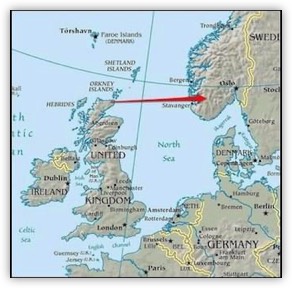

Operation Freshman - The Rjukan Heavy Water Raid 1942
On 21st November 1942, the following announcement was made over the German Wireless
"On the night of November 19-20th two British bombers, each towing one glider, penetrated Southern Norway. One bomber and both gliders were forced to land. The sabotage troops in the gliders were engaged and killed to the last man."
After the War had ended, the official account of the British First and Sixth Airborne Divisions "By Air to Battle" was published by HMSO in 1945. The 144 page booklet contained the following brief statement:
On November 19th, 1942, two Halifaxes, towing two Horsa gliders, set off from an airfield in Scotland for an objective in southern Norway. The importance of the objective was such that all risks had to be taken. (It was a heavy-water plant connected with German research on the atomic bomb. A later raid on this plant was successful.) This was the first time that British gliders set out to attack the enemy.
They were flown, one by Sergeant M. F. C. Strathdee and Sergeant P. Doig of the Glider Pilot Regiment, the other by Pilot Officer Davis and Sergeant Fraser of the Royal Australian Air Force. Each glider carried fifteen sappers, all volunteers, under the command of Lieutenant Methven, G. M. Their task was to destroy the objective, and the difficulties were great. In the first place, the towing of gliders was an art in which the crews had not as yet had much practice. Secondly, the tugs had to be adapted and their engines, having to pull the added weight of the glider behind, developed defects, particularly in the cooling system. Fortunately these and other troubles were discovered during the practice tows and were remedied, so that on the night of the operation two Halifaxes were serviceable, though a third held in reserve could not be flown.
The greatest difficulty of all was that caused by the distance to be covered, some 400 miles, and the necessity for extremely accurate navigation over the mountainous district in which the objective lay.
In every air operation all ultimately depends on the weather, and on this occasion a correct forecast was of vital importance. On the morning of the attempt, thick cloud for most of the way, but clear skies and a good moon over the target area were promised. The two Halifaxes took off while it was still light and set course for Norway. Almost immediately the intercommunication system connecting the gliders and the tugs broke down. One Halifax kept low, seeking to fly beneath the cloud and then to gain height on nearing the Norwegian coast, where the pilot hoped for clear weather. What happened is not exactly known, but at some moment the tug hit the side of a mountain, crashed, and all its crew were killed. The violence of the shock loosed the glider, which made a very heavy landing close by, killing and injuring several of its occupants.
The other Halifax was more fortunate. It flew high and approached the Norwegian coast at 10,000 feet. Here, as promised, the weather cleared, but it was found impossible to locate the landing zone. Though they were the best that could be got, the maps were exceedingly inaccurate, and the necessary pin-point could not therefore be obtained. The whole district was covered with snow which made the identification of objects on the ground even more difficult. The pilot of the Halifax, Squadron Leader A. B. Wilkinson, with his commanding officer, Group Captain T. B. Cooper, DFC, on board, made every effort to find the right spot, until, with petrol running low, he was forced to turn for home. The glider was still at the end of the rope, but on crossing the coast the combination ran into heavy cloud and icing conditions, the air became very bumpy, and the two parted. This glider, too, made land and crashed not very far from the other. The survivors of both gliders were captured and almost immediately fell into the hands of the Gestapo. Read about the recovery of Operation Freshman Horsa Glider DP349 here
The Fuehrerbefehl On 18th October 1942, Hitler issued the Fuehrerbefehl which accused Germany's opponents of using methods that did not conform with the international agreements of the Geneva Convention. He singled out commandos for special mention, describing their behaviour as 'especially brutal and cunning'. Commandos, he stated, were partly recruited from among hardened criminals in their own countries, and it appeared from captured documents that they were instructed not only to bind prisoners, but also to kill defenceless prisoners out of hand as soon as they believed they could be an obstacle to their purpose. Orders had been found in which the killing of prisoners had been demanded on principle.
The crux of Hitler's order was this:
From now on all opponents brought to battle by German troops in so-called Commando operations in Europe or in Africa, even when it is outwardly a matter of soldiers in uniform or demolition parties with or without weapons, are to be exterminated to the last man in battle or while in flight. In these cases it is immaterial whether they are landed for their operations by ship or aeroplane or descend by parachute. Even should these individuals, on their being discovered, make as if to surrender, all quarter is to be denied them on principle.
The order continued:
If individual members of such commandos working as agents, saboteurs, etc, fall into the hands of the Wehrmacht by other means - e.g., through the police in any of the countries occupied by us - they are to be handed over to the SD immediately. It is strictly forbidden to hold them in military custody, e.g., in PW camps, etc., even as a temporary measure.
The outcome for those involved in Operation Freshman
The 2 Airspeed Horsa assault gliders each carried 2 pilots and 15 airborne engineers. The 23 survivors of the 2 glider crashes were executed in accordance with the instructions of the Fuehrerbefehl. All 7 crew members of the Halifax that was lost were killed in the crash.
Extracts from: Operation Freshman, The Rjukan Heavy Water Raid 1942 by Richard Wiggan ISBN 0-7183-0571-X

Recovery of the Wreckage of Operation Freshman Horsa DP349
In September 2004, a 5 man team consisting of 4 serving RAF personnel and a Norwegian military historian, conducted a successful expedition to Norway to recover the wreckage of Horsa DP349. DP349 which crashed near Fyljesdalen to the north-east of Stavanger in the early hours of 20th November 1942. This aircraft was one of 2 Horsa aircraft and Halifax tug combinations involved in a daring attack on the heavy water plant at Rjukan. Heavy water was an essential part of the German nuclear programme, and was required for the production of an atomic bomb. Operation Freshman did not succeed, as both gliders and one Halifax tug crashed. The survivors from the glider crash landings were executed on the direct orders of Hitler. The crew of the Halifax died when it crashed near Helleland.
The remains of the Horsa were recovered with the full co-operation of the Norwegian armed forces and with help from the local community. Although this aircraft was the subject of an earlier expedition in 1985, significant wreckage was found, with approximately 300 items being recovered. The remains of the altimeter, cockpit perspex, and clear vision panel were found, along with metal and woodwork from all parts of the aircraft. Wing and fuselage plywood covering, complete with original paint and markings were donated by the owners of the land where DP349 crashed. The plywood had been used as roofing on a shed.
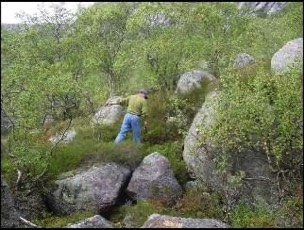
Above: Glider crash site
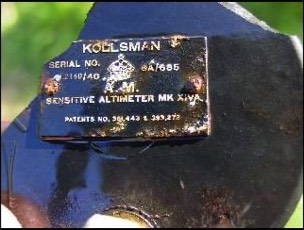
Above: An exciting find, the remains of the altimeter
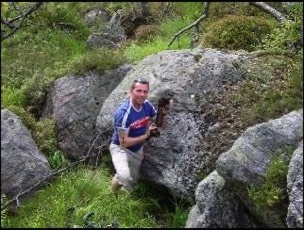
Above: Wreckage soon starts to appear
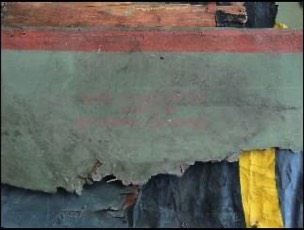
Above: Pieces of the glider's plywood skin
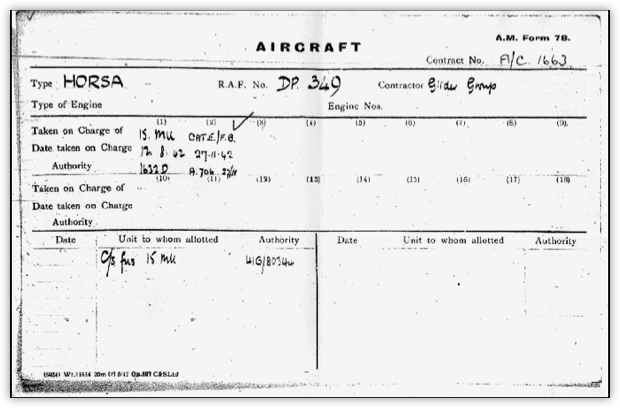
Above: Air Ministry Form 78 for Horsa DP349. The form was used to record the allocation of an aircraft to a unit
9mm Cartridge
One of the more interesting items recovered from the crash site of Horsa DP349 was a single 9mm cartridge which looked as if it had exploded in the fire that occurred some time after the crash. The head-stamp was clearly visible, reading as * P * 1934. I approached the members of CartridgeCollectors.org for assistance and received a comprehensive reply.
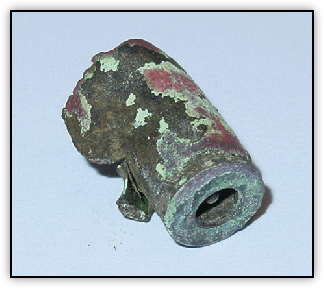
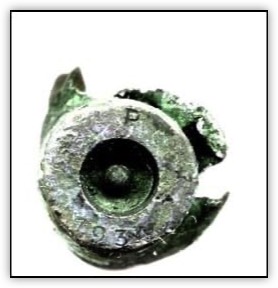
To CartridgeCollectors.org
I've just returned from an expedition to Norway to recover the remains of one of the Airspeed Horsa assault gliders used in the attempt to destroy the German heavy water production and supplies at Vermork (Operation Freshman).
The gliders both crashed on 19/20th November 1942, and were carrying combat engineers armed with both Lee Enfield SMLE .303 rifles and 9mm Sten guns. We recovered a great deal of wreckage, mostly small metal brackets and wood (the gliders being largely constructed from wood) but only found one item of ammunition.
I've attached pictures of the cartridge that we found, which I believe was 'cooked off' in the fire that consumed the wreckage some time after the crash. By the time the fire occurred, German troops had already searched the wreckage and the dead and wounded had been removed. There was no firefight when the Germans arrived, as the British airborne troops were in no shape to put up a realistic resistance. The headstamp of the 9mm(?) round is difficult to read, but as far as I can make out, it is as follows:
P
* *
1934
I initially assumed that this cartridge was a British item lost by one of the British airborne troops, however, looking at the cartridgecollectors website now I'm not so sure. I'm fairly sure that the case is brass, although it's difficult to say if it is plated. It is possible that this is a German cartridge, lost by one of the troops searching the wreckage after the crash.
I would be very interested in your comments regarding the origin of this cartridge.
Reply from CartridgeCollectors.org
The cartridge case you found is a product of Hirtenberger Patronen-, Zündhütchen-und Metallwarenfabrik A.-G. Hirtenberg, Austria. This was probably a contract load for either Bolivia or Paraguay during the Chaco War (1932-1935). Only encountered with the 1934 date you found, it occurs in boxes marked “Dordrecht” indicating it was made, or perhaps loaded, at the Hirtenberger facility in Dordrecht, Holland. As can be seen below, the box label is in Spanish.
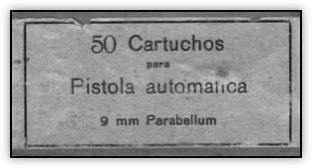
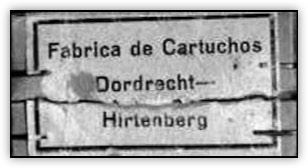
Now, how did a load for the Chico War get in your glider. There is significant evidence that the British government purchased a significant quantity of 9mm Parabellum ammunition from wherever they could find it. They also contracted Winchester to make quite a bit of this ammo. The fact is that British 9mm production was just ramping up in 1942 (the first year of full production) and the quality of the British made ammunition left a lot to be desired. The British did not have an adequate pistol powder for the 9mmP and used a chopped cordite in the Mark IZ loads produced in 1942 and much of 1943, when a better powder became available. I have seen boxes of German ammo, probably produced for the Spanish Civil War that were issued in Britain. For a raid like Operation Freshman, I suspect that the British troops were provided the best ammo available which was not the current British production.
Thanks to CartridgeCollectors.org and Lew in particular for this amazing reply.
Update received April 2009 from Britain at War Magazine
Britain At War
After our recent article in Britain At War magazine we have received many emails in relation to Operation Freshman. In particular, a lot of interest has been raised regarding our Op. Freshman artefacts as can be seen by this letter extract:
In Issue 23 in the article about Operation Freshman, you postulated that the Austrian 9mm Cartridge case found could have been issued to British troops.
I can confirm that was indeed so. In 1941 Britain purchased 20 million rounds of 9mm Parabellum ammunition from Bolivia and these were the rounds made by Hirtenberger. However, they were not made in Austria but at Hirtenberger's Dutch subsidiary at Dordrecht. The contract record is in theNational Archives and British military Pamphlet 11A, "S.A.A. Below 20 MM", dated April 1949 states ".ammunition of the following make was issued to the Service early in the late war:- Cartons marked:- "Cartuchos para pistole automatica 9mm.parabellum fabrica de cartuchos Dordrecht Hirtenburg."
Incidentally, the previous edition of the Pamphlet dated 1945 states that Italian 9mm ammunition headstamped GB was also issued. This ammunition was issued, but it was not Italian. It was originally made by an unknown manufacturer, probably German, and came in packets marked in Spanish similarly to the Hirtenberger but without the makers name. I suspect this also came from the Bolivian contract.

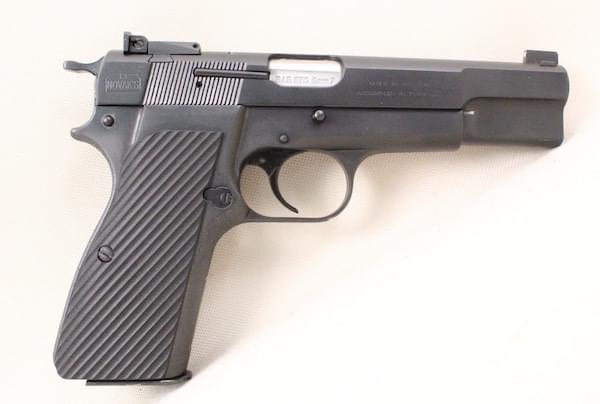
The airborne troops engaged in the operation would have been armed with a variety of weapons, but the only two that used the 9mm ammunition were the British made 'Sten' submachine gun and the Fabrique Nationale (FN) 9mm Hi Power semi-automatic pistol produced in Belgium. Interestingly, the Hi Power pistol was used by both allied and axis forces during WW2 and was the standard side-arm in the British Forces until 2013 when it was replaced by the Glock 17 pistol.
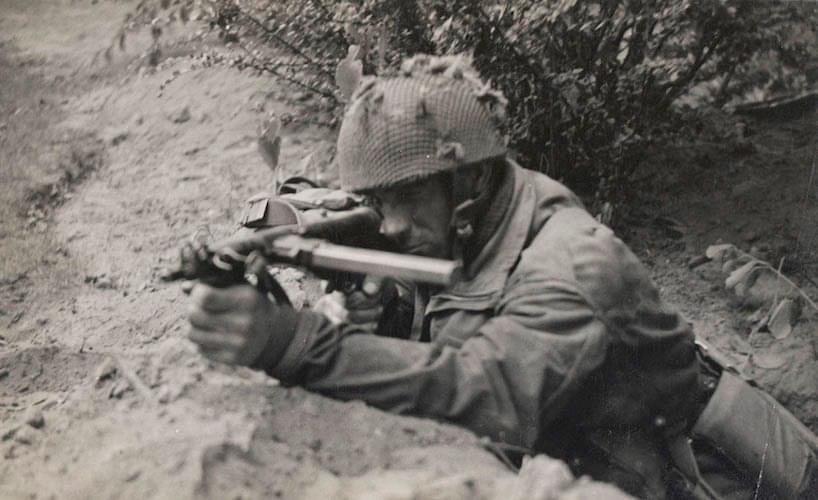
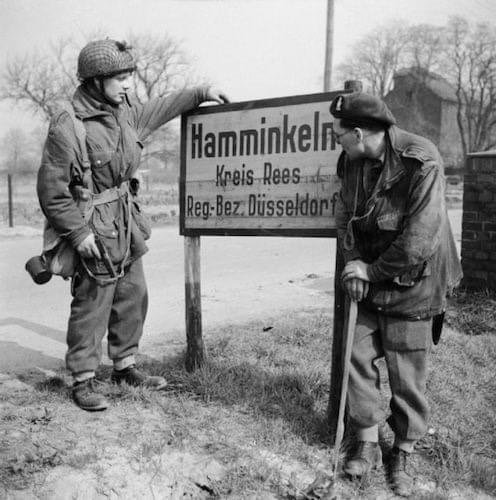
Horsa DP349 Altimeter
The cockpit of Horsa DP 349 was destroyed in the crash in 1942, however, a number of items from the cockpit were discovered in a shallow “V” shaped ditch. One of the most interesting items was the remains of the altimeter complete with the makers plate on the rear. The altimeter was made by the American company Kollsman who still produce aircraft instruments. I contacted Kollsman to see if they could tell me anything about the Altimeter.
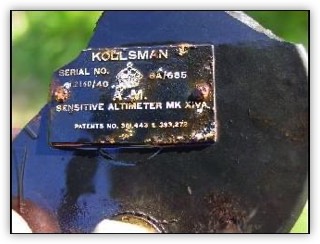
The remains of the altimeter fitted to DP349
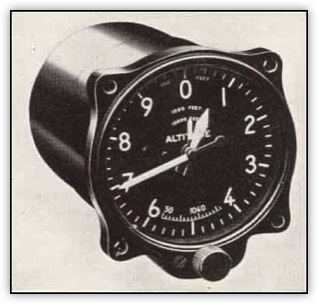
Mk. XIVA altimeter in the Kollsman pattern case
To Kollsman:
I have just returned from a Royal Air Force expedition to Norway to recover parts of one of the Airspeed Horsa assault gliders used in the attempted attack on the Heavy Water plant at Vermork (Operation Freshman) on 19/20 November 1942. Both of the gliders crashed due to poor weather and inability to successfully find the landing area, and the survivors of the crash landings were executed on the direct orders of Adolf Hitler. Horsa DP349 crashed near to Lysebotn, and it is the remains of this aircraft that the expedition set out to find. Although the aircraft was extensively damaged on landing, and subsequently caught fire due to a pyrotechnic accident when being examined by one of the local population, we have found significant wreckage both on and below the surface. One of the most interesting finds is fragments of the altimeter (picture attached). The details of the altimeter are as follows: Kollsman Sensitive Altimeter Mk XIVA Serial No. 2160/40 6A/685 Patents No. 381, 443 & 393, 272 I would be very interested in any information that you can give me regarding this instrument.
Reply from Kollsman:
I am in receipt of your e-message and photograph. Unfortunately, I am unable to locate any information, whatsoever, on the altimeter in question. Because this altimeter had early WWII applications, its age exceeds the oldest records I can locate that contain usable data. I have made a note of the part/type number and will keep looking, and of course will transmit any data I can find
Regards
KOLLSMAN PRODUCT SUPPORT